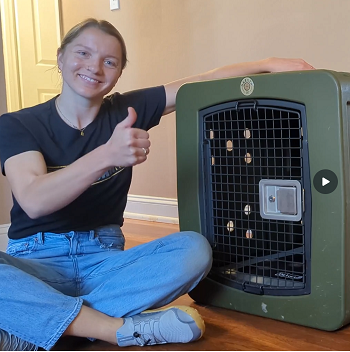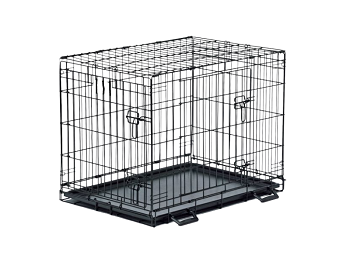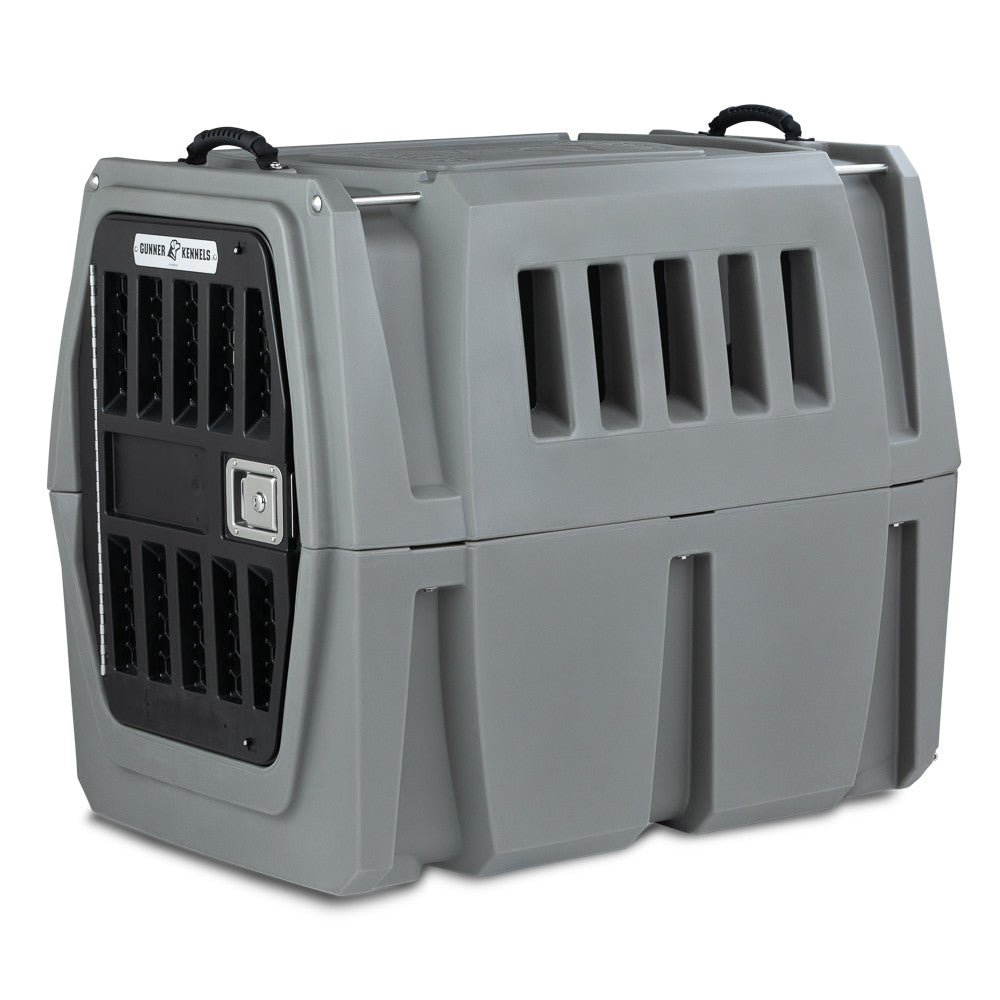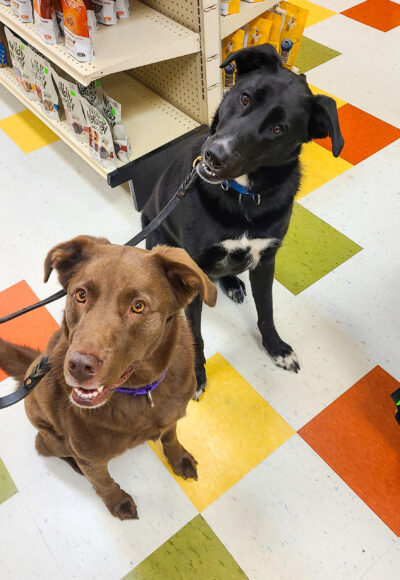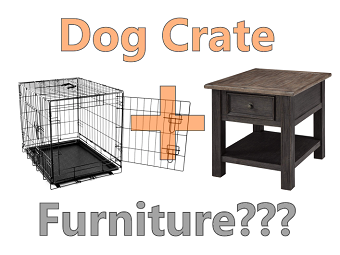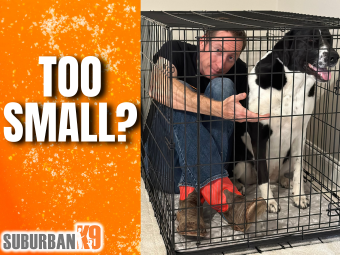Kenneling/Crate Training Your Puppy
I will save you the suspense. We are 100% in favor of kenneling all puppies when they are unattended. A puppy generally does not have enough impulse control to resist chewing things they shouldn’t and this can lead to big trouble! Many puppies consume things such as medicine, carpet and clothing when they are left unattended and this leads to a lot of unnecessary surgeries and even deaths. When someone tells me that they won’t cage a puppy because they wouldn’t cage their young child I tell them that is perfectly fine. Just take the dog everywhere with you or hire a sitter like you would for a young child! You should never leave a three year old child unattended running around your home and you shouldn’t leave a young puppy in that manner either. If you want help with your dog, check out the Suburban K9 Difference to learn more about us and the services we offer!
What to Consider about Crating your Dog?
- Dog Safety
- Natural Desire to Den
- Potty Training
The first and most important reason to crate train your puppy is that they are not mentally mature enough to be left on their own. Many puppies die each year after eating things they shouldn’t when they are left unattended. This can be prevented so easily! Simply don't leave your puppy unattended or when you do leave them make sure it is with them in a safe place. The safest place we can think of is in a crate!
Another great reason to crate train your puppy is that dogs are naturally den animals. In their den they feel safe and secure, so it is easy for them to relax and sleep. This is why many dogs sleep in the corner of the room, under a table or behind a chair. It's called Denning Up and it's natural for them! Crating your puppy can serve as their den and help them to relax and sleep. Remember that dogs are not humans and very well might enjoy different things!
The last important reason to consider crating your dog is potty training. The crate is a great tool to help your dog get headed in the right direction in potty training. If your pup has free rein of the entire house when you aren't watching them, it makes potty training extra difficult. If you want help with how a crate can help with potty training, check out our Potty Training Academy.
Sizing your Dog's Crate
The first thing you need to consider when kenneling your pup is the size of the crate. It is imperative that the kennel is tall enough to let your pup stand all the way up with their head stretched high. If they can’t stand all the way up the kennel should be replaced immediately. They should also be able to turn around fully while inside the crate. For a very young puppy you want the crate to be just big enough, but not too big. If it is too large they are more likely to have accidents in it. Many crates come with dividers to make them smaller for young dogs. Once they prove that they can hold their bladder through the night you can remove the divider or buy a larger crate.
If your crate didn't come with a divider you can find Crate Dividers on Amazon that have great reviews and fit most crates.
What Crate Should I Buy for My Dog?
The type of crate you use is dependent on both your dog and your lifestyle. For the average dog, a typical wire crate that you see at most pet stores will work wonderfully. These are not expensive and are great for dogs without separation anxiety issues. If your dog tries to break out of the crate you will definitely need something stronger and safer.
Crates for Dogs with Separation Anxiety
- Dimensions: 41.25" H x 42.25" W x 30.75" L
- 20-Gauge Steel Cage This ProSelect Empire dog cage is extremely strong with reinforced 0.5-inch diameter steel tubes and 20-gauge steel
- Floor Grate With Tray Cleanup is easy with this ProSelect dog cage because of its grated floor with tray
- Removable Casters You can attach casters to the bottom of the cage to allow for easily rolling the cage to other locations or leave the casters off for added stability
- Durable Dog Cage The Empire cage will stand up to the toughest abuse from the largest dogs with strong latches and thick steel construction
Separation anxiety is a major issue facing a good number of dog owners. When a dog has separation anxiety it is likely that they will try and escape from their crate. This can cause damage to the crate, allow them to damage your home, or injure themselves escaping or after they have escaped. If your pup is having separation anxiety, we highly recommend that you work with an experienced trainer immediately. You can request a quote from us for our training services. For separation anxiety we would always recommend that you start with In-Home training as opposed to a Board and Train Program, this will allow the trainer to see and address the issue first hand where it is occurring and give you the best advice. They will likely recommend utilizing the crate to help the dog overcome the anxiety and have plenty of home work for you to do! The Empire Pro Select Crate is great for dogs that have a history of trying to break out and the price is extremely reasonable. Our company has around 40 of these crates and have never had an issue with them. We do recommend them to clients when their dogs have separation anxiety. The bars on these crates are made of a thicker material and do not bend easily. They also have a crate pan underneath a grid of bars. This keeps the dog from being able to push the tray out and escape out of the bottom of the crate.
Best Crate for Traveling with your Pup
If you travel with your dog and want a tough crate that can be used at home and in a vehicle, then check out our top pick for traveling Gunner G1. In addition to the Gunner G1 there are great options for traveling in Veri-Kennels. These are plastic kennels that usually have a wire door and can be utilized on planes but are also easy to place in SUVs and even some sedans for road trips with your dog. They tend to be lightweight and are very easy to carry and move.
Another reason that crating is important if you ever feel like you might travel is that many boarding facilities utilize crates for your dog while you are gone. It is possible to find a boarding facility that doesn't use crates, if you are looking for this, make sure to search for Doggie Suites. If your dog has never been crated this could be a big issue when you go to leave them. Some people might say they won't board their pup, but just know that something will generally come up in life where this has to happen. Having the ability to easily crate your dog will put your mind at ease if boarding is ever necessary.
Great Crate for Your Well-Behaved Pup
If your dog is well behaved in a crate (no separation anxiety) here is a link to an inexpensive wire crate. These are great crates for inside your home. They tend not to be good for travel or even moving around all that much as they don't break down easily and are fairly heavy. There are also a large number of crate dividers available for wire crates, so it is easy to use them throughout your dog's entire lifecycle. If your dog has any signs of trying to break out of their crate, we wouldn't recommend a standard wire crate like this. The corners where the wire sections meet tend to be somewhat weak and are a frequent escape points for dogs.
Other Crates You Should Consider

- FARMHOUSE FURNITURE STYLE Featuring barn doors, farmhouse and bracket decor, the dog crate furniture is both modern and casual feel.
- WATER RESISTANT Baseboards are designed to be water resistant and anti-soak.
- REMOVABLE DIVIDER The removable divider design makes the dog cage more creative.
- sturdy and comfy dog crate creates a cozy space for the dog and brings it a sense of security.

- Sturdy Plastic Dog Crate: Securely and safely protect your pet and your home with this dog crate
- Suitable for Dogs of All Sizes: 5 different sizes to choose from
- Airline Friendly Dog Carrier: This pet carrier meets most airline cargo specifications
- Easy to Keep Clean: Sturdy plastic shell on this dog carrier is easy to clean

- LARGER ROOM Suitable for dog breeds up to 90lbs.
- TWO SPACIOUS ROOMS Features a removable divider.
- STURDY DOG CRATE Thick metal fence is solid while providing visibility and ventilation.
- EXTRA LARGE STORAGE This furniture dog crate has a large tabletop, and four drawers
- Pre-assembled parts make installation easy and convenient
Where Should you Place your Dog's Crate?
People have many different opinions on this matter, but I prefer to crate very young puppies in my bedroom. They have just been separated from their mother and siblings and the first few nights can be really scary for them! If they are right next to your bed, they are less likely to be scared and stressed during the night. This allows you to calmly sooth them with your voice when they wake up so that they hopefully go back to bed! As the weeks go by you can move the crate farther from your bed and then eventually move it to your desired long-term location.
Where your crate or dog's sleeping spot ends up long term is completely up to you. It doesn't matter if your dog has its own dedicated spot or sleeps in the living room. One thing you should do is occasionally have your dog sleep in a different location. This will help them understand that they can relax in any location and will ease the stress of changes to their routine.
Safely Crating Your Dog
- Remove Collars and Harnesses.
- Don't place items around the crate.
- Don't give them things they might choke on.
Now that you have selected the right crate for your dog and placed in the best location in your home, it is important to use it safely. When placing your dog in the crate we recommend not leaving any collar or harness on them. A collar or harness can easily become snagged on your crate. This can cause a dangerous situation for the dog and can even lead to death. This may happen even if your dog is calm in the crate and not trying to escape. Even just turning around to get comfort could result in a collar getting snagged. For this reason, always ensure you remove and collar, leash, or harness from your dog before placing them in their crate.
You should not place their leash and collar/harness on the crate or directly next to it. With most crates, dogs could potentially drag items close to the crate inside and chew/destroy them. This can be hazardous to their health, just like leaving them out of the crate all together. It is best to have at least 1 foot clear around the crate on all sides. Another common issue is having electrical cords close to the dog's crate. Make sure to avoid this at all costs so that your dog does not chew on a cord and end up getting an unexpected shock.
While in the crate, make sure the items that you are giving your dog are safe. A common item to add to the crate is a blanket, rug, or pillow. Make sure that your dog will not chew/ingest these soft items before leaving them alone in the crate with them. We encourage the use of a Kong or other toy while in the crate. This can help give them something to do and reduce the likelihood of separation anxiety. A great trick is to freeze some peanut butter in Kong toy. This will make the treat last longer for the dog and really keep them occupied.
How do I stop puppy barking in the Crate?
The first step to stop your dog from barking in the crate is teaching them the heel command. It may seem unrelated, but trust us, it helps! For more information on teaching a puppy the heel command read here!
After you teach your dog heel, you are ready to start the crate process. The more training you give your dog before you begin this process, the better! We will use treats if necessary to help guide this puppy into the crate. Whether you use treats or for how long you use them depends on the dog. Overall, we do not want to rush this process and need to make sure we are working at a pace that makes sense for your dog.
Now that your dog has entered the crate a few times, we will slowly start expecting more of them. This next step is to make sure your dog is learning the crate command. We use heel and light leash pressure if needed to help guide the dog in. One of the most essential parts is to make sure the dog is not bolting out when we open the door.
Once you have built a good foundation of positive experiences with the crate, we are ready to slowly build up time. If we did our job well, your dog should be doing better at this step. As we build up time, we want to start correcting any chewing, thrashing, excessive whining or barking.
One thing to keep in mind is you should try and make the crate a positive experience. We recommend giving your puppy something to chew while in the crate but be mindful if they are heavy chewers. Some of our favorite things to provide dogs to chew while in the crate are antlers or the Toppl West Paw.
For more detailed instructions, watch our video below!
Should you let your older dog sleep outside their crate?
When will they be able to go without a crate?
I generally start leaving the crate door open at night with the bedroom door shut once I trust the pup to sleep through the night and not cause mischief. This can be between four and eight months of age depending on their temperament. While doing this, make sure that you pay close attention to your dog the first couple of nights. It might even mean pretending to go to bed, but staying up on your phone to listen if the pup is up and moving around. If they prove they are able to do this well after a few weeks of them sleeping in the bedroom with the crate door open and the bedroom door shut, I will start leaving the bedroom door open if they have earned my trust.
Once they are able to sleep outside
You are probably excited to start leaving them out when you leave! Don’t go too fast at this point and remember that your dog’s life is at stake. If they swallow something they shouldn’t while you are at work, it could have devastating consequences. I generally wait until sometime between ten and eighteen months before leaving a dog out of the crate while I am not home. I will start with a ten-minute trip and then increase the time by ten minutes each time I practice. Don’t go from ten minutes to suddenly leaving for eight hours! That is asking for trouble.
Crate Training FAQ
Not at all! When trained correctly, crate training your puppy helps creates a safe and comforting space. The crate will become a den-like environment for them and will be a place they can go to reduce anxiety, not increase it.
This will vary based on your pup. A good rule to utilize involves using the puppy's age. Puppies can typically stay in a crate for about 1 hour for each month of age (up to 4–5 hours). As an example, a 10-week-old puppy should be let out every 2.5 hours or so. This should help ensure the puppy is not having accidents inside the crate. Make sure your pup is getting enough playtime and exercise outside the crate.
No. The crate should never be used as punishment. If used for punishment your puppy may begin to associate it with stress instead of calmness. Make sure you are using the crate in a positive manner.
Making some noise inside the crate is normal when you are starting out with crate training. Stay calm, avoid giving in, and only let your puppy out when they’re quiet. Reinforcing quiet, calm behavior helps them adjust faster. If the puppy doesn't calm down, you should consult with your trainer for the best course of action to move forward.
Yes! Crates are the number one tool for potty training! This is because puppies naturally avoid going potty in their sleeping area. To help, make sure and take them outside frequently and before putting them in the crate. Other key times to take them potty are after meals, play, and when taking them out of the crate.
Final Verdict on Crating Your Pup
We think that crating your pup is an important tool in the training and long-term care of your dog. For this reason, we strongly recommend teaching your dog to utilize a crate. Use the advice in this article to pick the right crate, place it in the right location and use it with your pup safely. If you'd like to schedule a lesson with an expert dog trainer to help with any crate issues you are having, you can request a price quote today.
The article above contains Affiliate Links from Amazon and other companies. If you visit their site and buy the product, we will get a small commission. Please know that we only recommend products we truly love and would never recommend a product we don't think is incredible. We look at and try hundreds of products before we ever recommend them to our clients!


